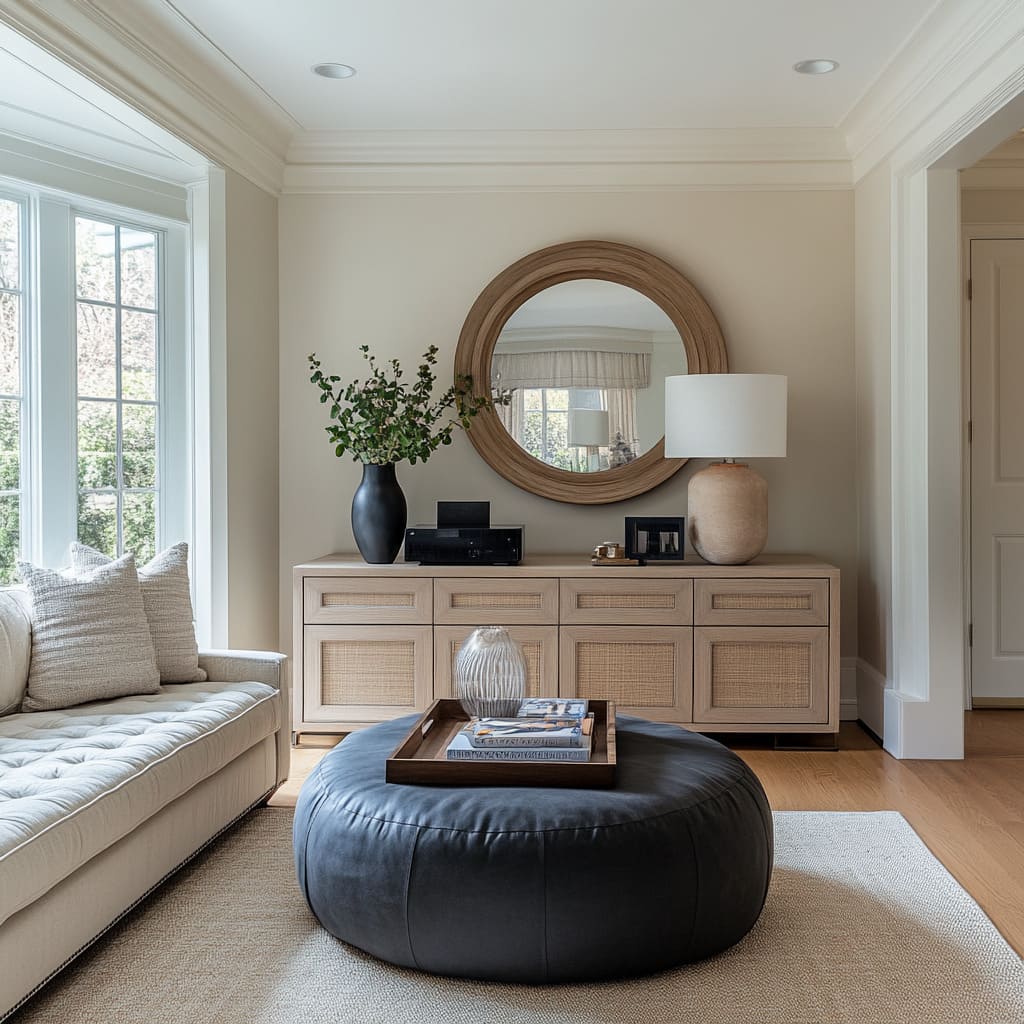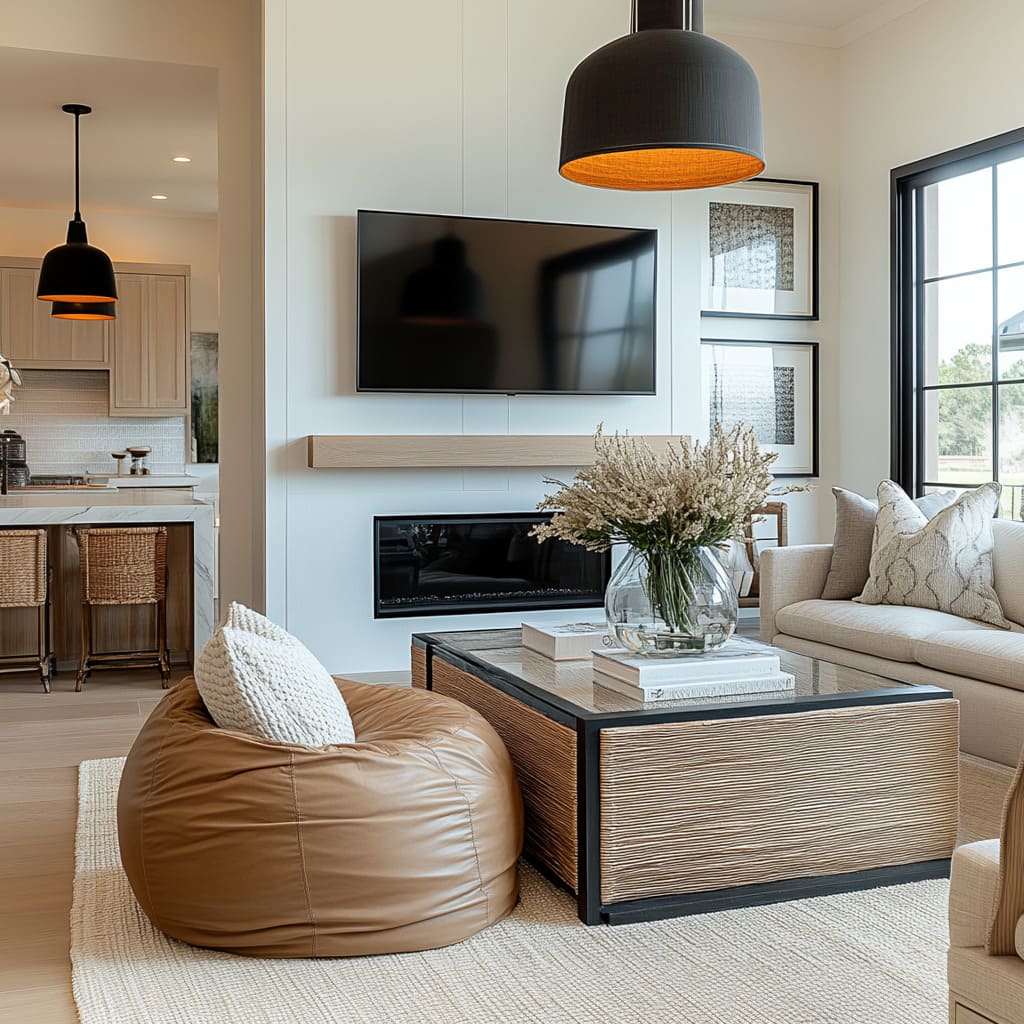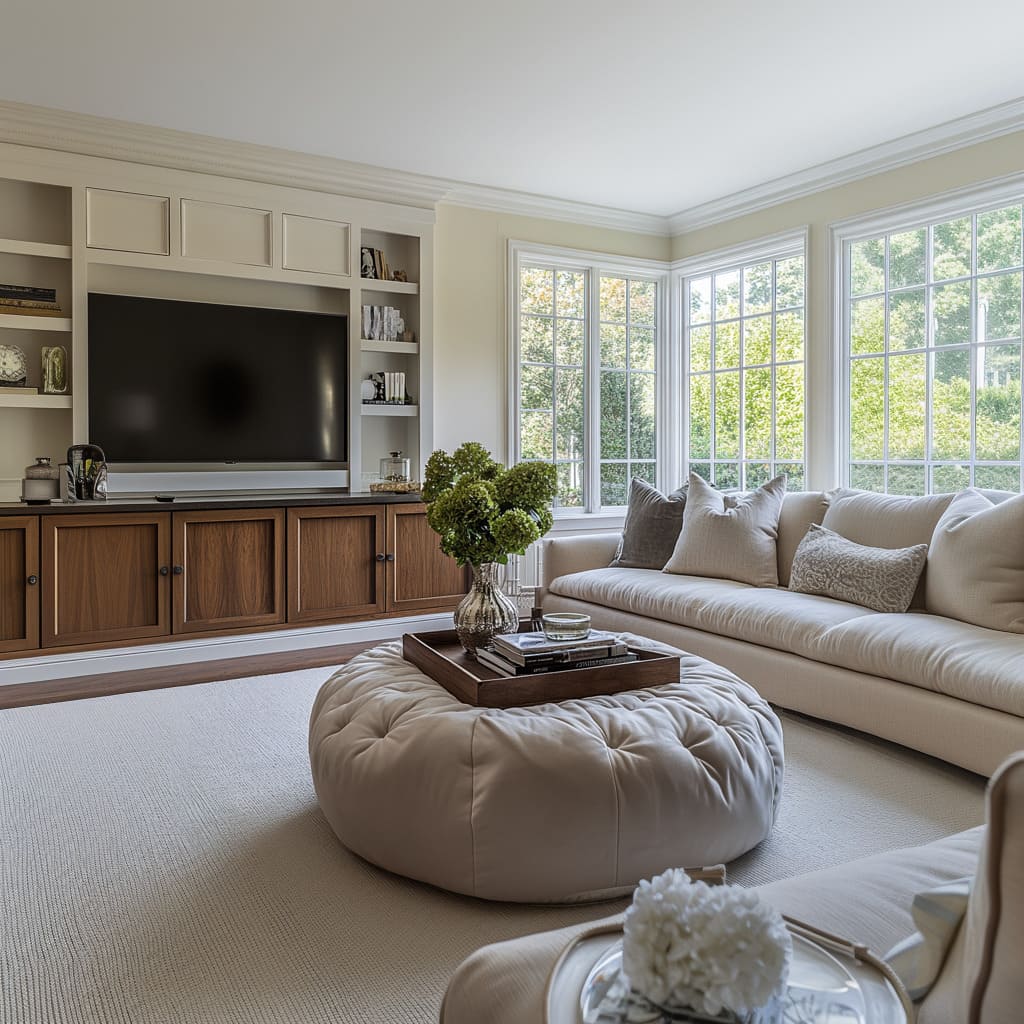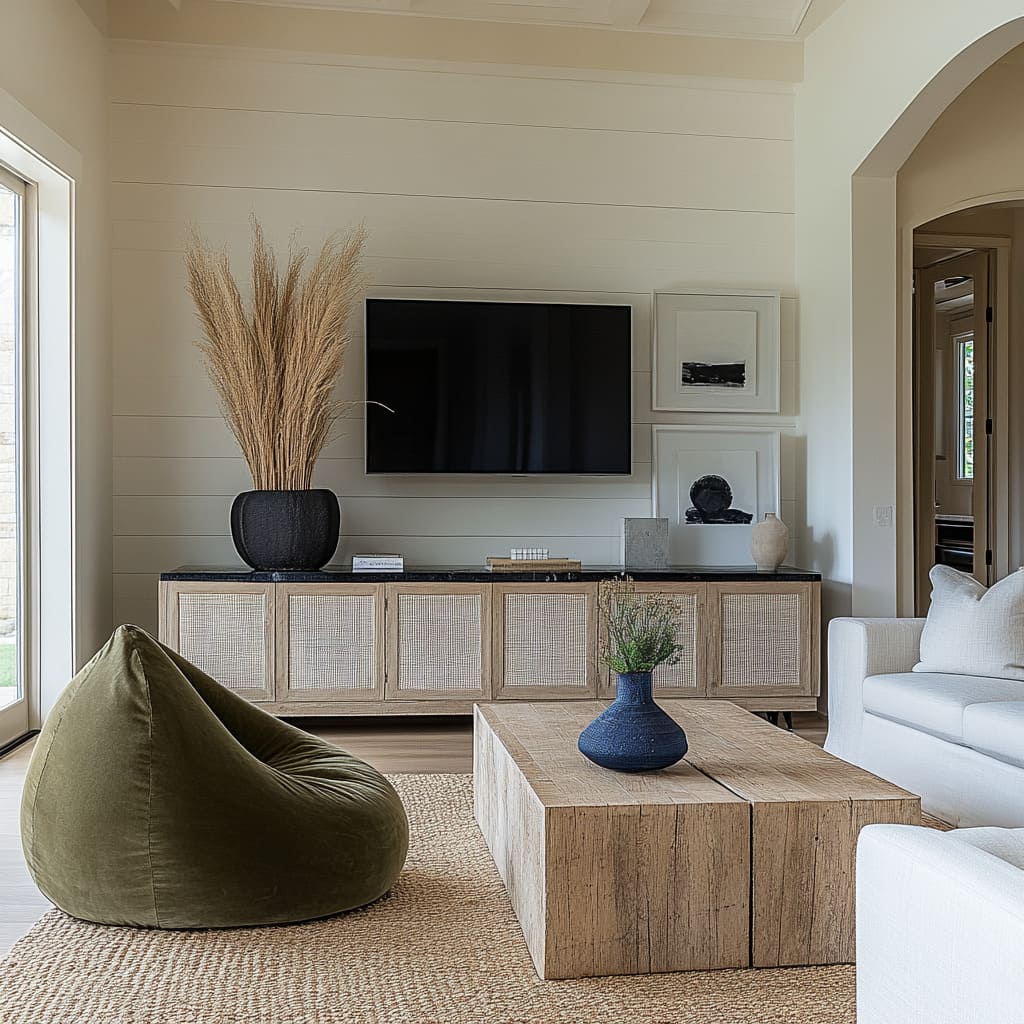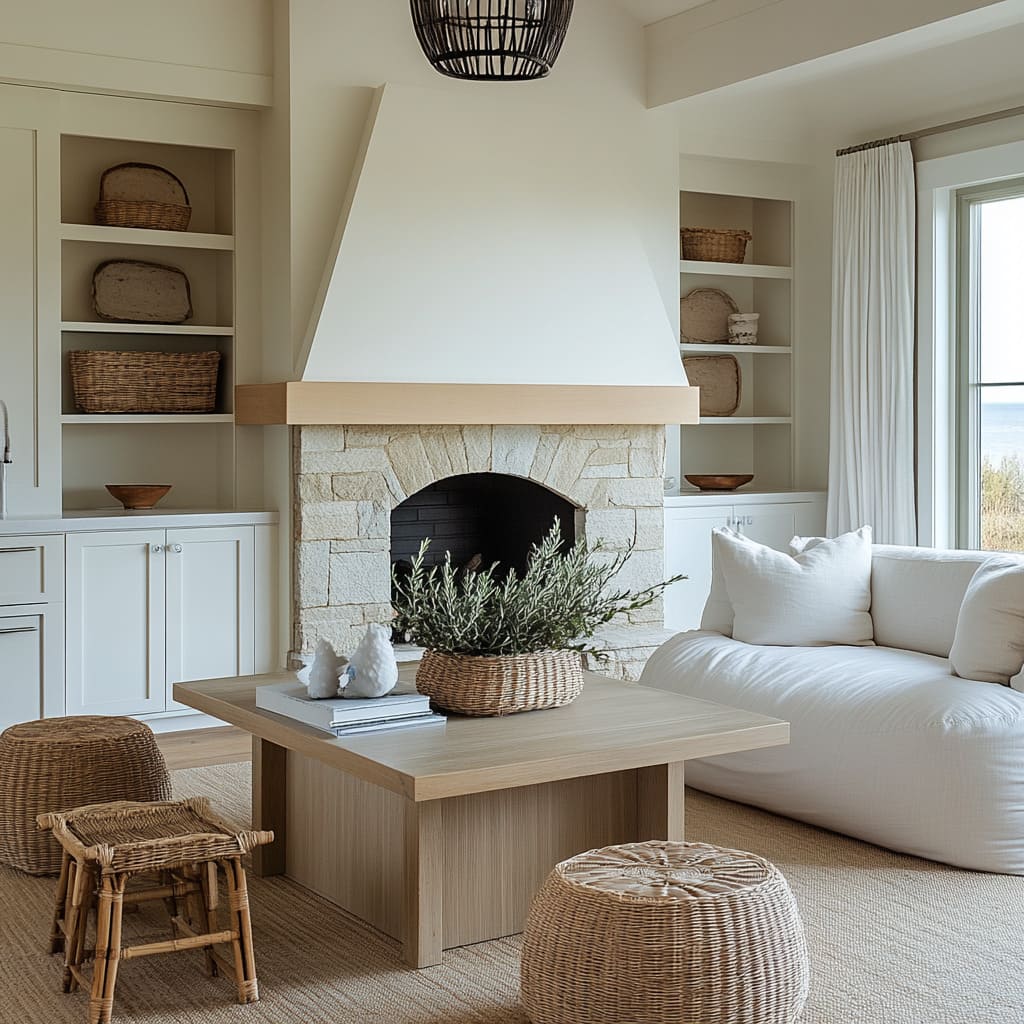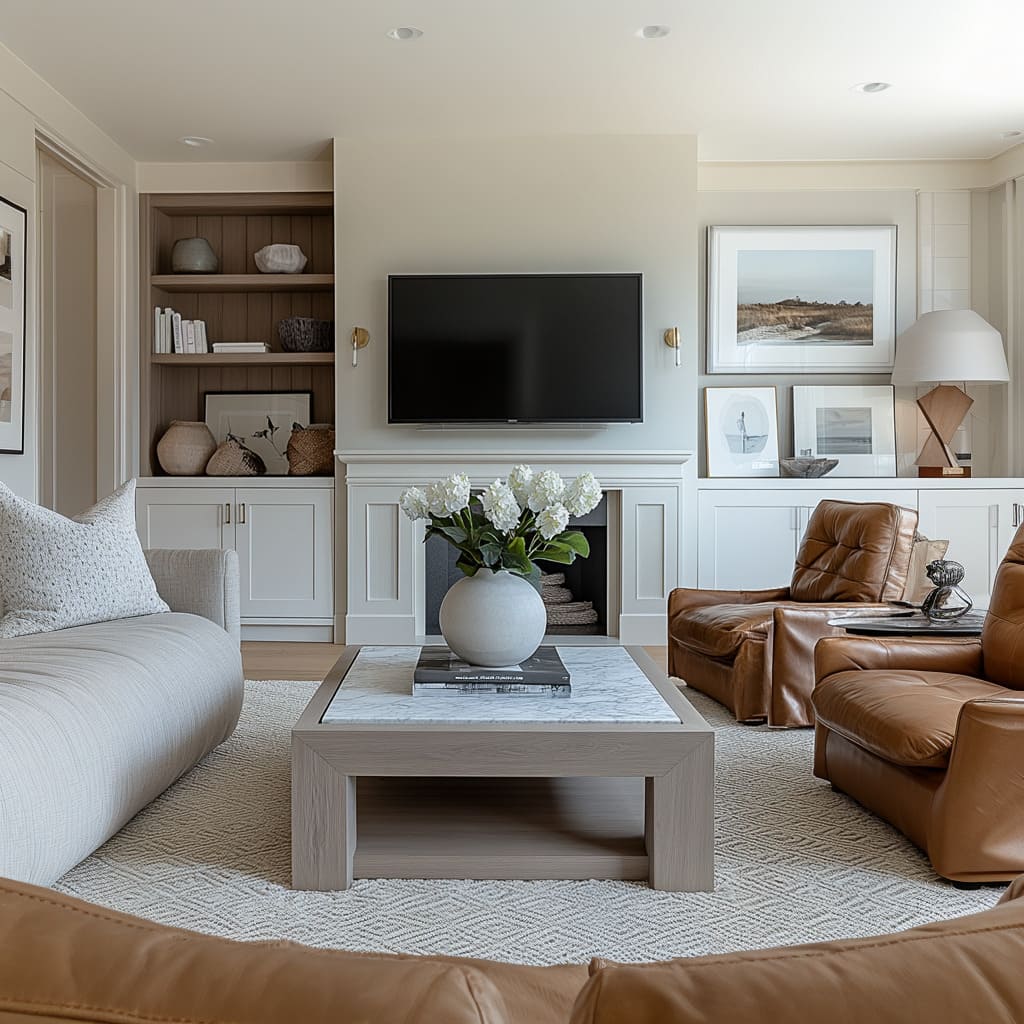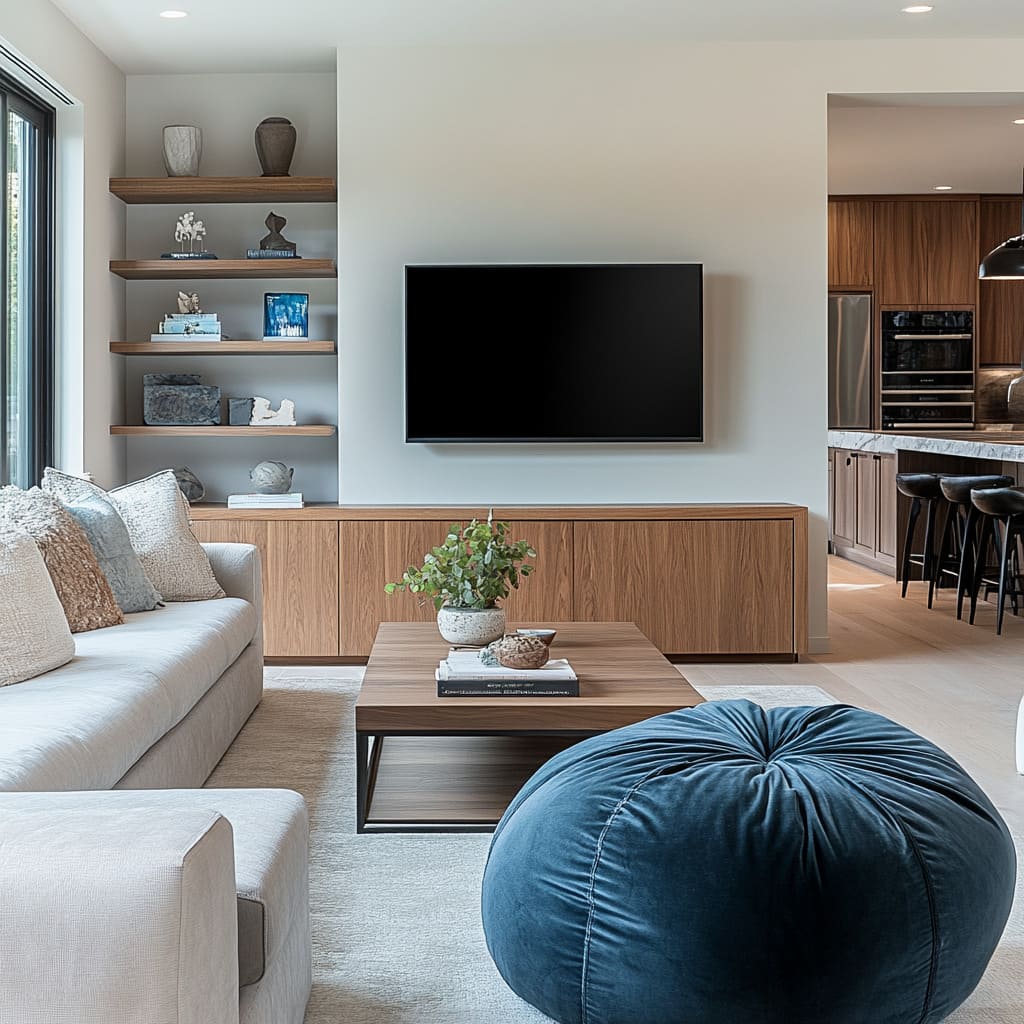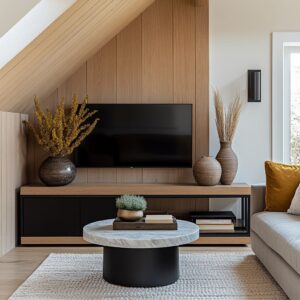Creating the perfect living room is about far more than choosing a comfortable sofa. It’s a carefully thought-out mix of furniture, textures, and colors that work together to transform a space into something both practical and beautiful.
This article breaks down how modern living rooms achieve their charm, from thoughtful layouts to clever pairings of organic materials and refined finishes. We’ll look at how light wood tones balance soft upholstery, why tufted ottomans are stepping up as unexpected focal points, and how the smallest details—like a simple vase of greenery—can tie a whole space together.
Whether you’re planning to revamp your home or gathering modern living room ideas for inspiration, understanding these subtle choices will help you see why some living spaces just work. Drawing from trends in contemporary American homes, we’ll explore how designers blend classic features like built-in shelving and fireplaces with the clean lines and minimalism of today’s style.
Get ready to uncover the small decisions that make the biggest difference—because every element in a room serves a purpose, and nothing is there by accident.
Today’s Design Trends In Living Room Designs
Natural Materials and Organic Textures
One of the most noticeable shifts in modern living room designs is the embrace of natural materials and organic textures. These elements bring warmth, depth, and a sense of balance to interiors while enhancing the overall aesthetic.
Rattan and wicker have become go-to materials for coffee tables, console accents, baskets, and light fixtures. Their tactile, woven texture contrasts beautifully with smooth, modern lines, softening the look of contemporary spaces.
These pieces feel approachable and timeless, offering a nod to nature while adding visual interest. Wood finishes, particularly light oak and warm walnut, dominate furniture selections like shelving units, media consoles, and coffee tables.
These tones add richness to spaces, acting as the perfect counterbalance to white walls and neutral decor. Light wood grounds the room, while darker walnut adds depth, bridging the gap between modern minimalism and more classic touches.
Stone and marble also play significant roles, especially in fireplaces and tables. Whether in natural gray stone surrounds or sleek white marble tabletops, these materials add texture and weight, creating focal points that feel grounded without overpowering the design.
The use of stone reflects a trend toward blending luxury and subtlety, achieving an elevated yet natural look.
Neutral and Calming Color Palettes
Color in today’s living rooms focuses on building calm, open environments while allowing for curated moments of personality. Neutral tones dominate the backdrop, while thoughtful accents add charm and energy to the space.
Primary tones like whites, creams, light grays, and soft beige set the stage. These colors work as a clean canvas that reflects natural light, making rooms feel bright and airy.
In smaller living rooms, the soft palette visually expands the space, providing an effortless and calming foundation.
Pops of accent colors—including navy blue, muted caramel, and sage green— are introduced through throw pillows, ottomans, vases, and artwork. These subtle touches of color bring in depth and personality without overwhelming the neutral palette.
Whether in coastal-inspired spaces or modern family rooms, accents offer just enough visual interest to feel intentional. Monochrome layering is another clever trend.
Designers mix varying shades of a single color family—such as beige, ivory, and light taupe—to create depth while maintaining cohesion. This layered approach ensures that the room feels sophisticated and complete, while keeping the palette refined.
Integration of Modern and Classic Styles
The most impactful living rooms today seamlessly combine modern design principles with classic architectural touches. This approach strikes the perfect balance between clean simplicity and timeless character.
Modern features like recessed fireplaces, sleek TV walls, and low-profile seating form the foundation of contemporary living spaces. These elements focus on function and clean lines, eliminating visual clutter and ensuring the space feels fresh and uncluttered.
However, many living rooms also include classic touches to retain a sense of warmth and history. Crown molding, wall paneling, and brick fireplace surrounds often add timeless structure to otherwise modern rooms.
Built-in shelving is another standout feature—offering both storage and a perfect stage for curated decor items like books, vases, and small artwork. The combination of these styles ensures that spaces don’t feel tied to fleeting trends.
Instead, they embody a design that feels current yet grounded, merging clean lines with textures and details that offer comfort and character.
Furniture Choices and Their Roles
Sofas and Seating
Sofas take center stage in modern living spaces, often acting as the anchor that shapes the room’s layout and flow. Whether the space leans minimal or layered with textures, the seating sets the tone for both comfort and style.
Sectional sofas, particularly large L-shaped options, are a popular choice for open layouts. Positioned strategically near windows, they embrace the natural light, creating a relaxed and inviting environment.
Their size maximizes seating while defining zones in more expansive spaces without the need for partitions or dividers. Tufted sofas bring a refined touch through texture and detail.
The tufting introduces a sense of classic design while still complementing more streamlined elements in the room. It adds depth without overwhelming the space, making it a go-to option in living rooms that blend modern and traditional aesthetics.
Accent seating plays a vital supporting role by adding variety and visual interest. Leather armchairs in caramel tones provide a contrast to softer fabrics, creating a tactile balance.
Bean bags and upholstered benches offer relaxed alternatives for seating, while materials like boucle, linen, or velvet ensure they fit seamlessly into the broader palette. These thoughtful additions strike a balance between functional and stylish, enhancing the seating arrangement as a whole.
Coffee Tables and Ottomans
Coffee tables and ottomans are more than just practical surfaces—they often function as visual focal points that tie the furniture layout together. Tufted ottomans are a standout choice, doubling as soft, inviting coffee tables.
Their texture adds warmth, while wooden trays styled on top bring structure and functionality. These ottomans bridge the gap between style and utility, making them perfect for homes with a relaxed, approachable atmosphere.
Natural wood coffee tables emphasize raw, organic finishes that complement lighter color palettes. Their simplicity grounds the room, balancing clean lines and textured accents.
The organic look of these tables pairs well with rattan details and other natural materials. For a more polished look, glass or marble tabletops bring a sense of refinement.
Glass adds visual lightness to the space, while marble introduces a sophisticated texture that feels luxurious without appearing too formal. Both materials prevent the room from feeling visually heavy, offering balance to the surrounding furniture.
Built-In Furniture and TV Walls
Custom-built units and TV walls are essential in contemporary living room ideas, providing practical storage while enhancing the architectural interest of the space. Media units designed with rich wood finishes and clean lines allow technology to blend seamlessly into the room.
Lower cabinets offer a clutter-free solution by concealing electronics, remotes, and miscellaneous items, while open shelving above creates opportunities to display carefully chosen decor like vases, books, and artwork. The mix of closed and open sections ensures both style and practicality are addressed.
A recurring trend is the fireplace-TV combination, where linear fireplaces are positioned directly beneath wall-mounted televisions. This layout creates a natural focal point that centralizes the room’s design, ensuring balance and harmony in the overall setup.
Textural details also elevate built-in furniture, with elements like rattan inserts and paneling adding subtle character to units. These woven details connect seamlessly to other organic textures throughout the room, making built-ins feel cohesive and intentional.
By integrating both form and function, these customized features enhance the living room’s aesthetic while keeping it highly usable.
Decorative and Functional Styling
Layered Decor for Balance
The thoughtful use of layered decor creates balance and dimension in living rooms, blending practicality with personality. Vases, textiles, and curated tabletop arrangements play a critical role in tying the design together.
Vases and greenery are standout additions. Large statement vases filled with dried pampas grass, eucalyptus branches, or fresh hydrangeas introduce organic movement to the space.
Their flowing forms soften clean, straight lines in furniture, while natural tones or ceramic textures complement surrounding elements like wood and stone. Placed on coffee tables, consoles, or built-in shelves, they bring an effortless balance between nature and design.
Textiles are layered to add comfort and warmth without overwhelming the neutral palettes. Throw pillows in soft, textured fabrics—linen, boucle, or light knits—sit comfortably on sofas, offering a subtle mix of materials.
Blankets or throws draped casually over armrests or ottomans enhance a lived-in, inviting atmosphere. These simple additions elevate the overall coziness and create visual interest through understated texture.
On coffee tables, stacked books and decorative trays bring order and balance to functional surfaces. The books act as visual anchors, offering height and structure, while trays introduce a layer of organization.
Styled with small vases, candles, or sculptural objects, they make the tabletop feel purposeful without looking cluttered.
Statement Lighting
Lighting fixtures in these living rooms are not afterthoughts—they’re deliberate choices that blend style and function. Unique lighting pieces add personality while enhancing the room’s architectural features.
Pendant lights are commonly used to establish a focal point. Woven pendants in natural fibers bring a relaxed, organic look, while industrial-inspired designs—like black matte finishes—create bold contrast.
Hanging above coffee tables or in key sightlines, these fixtures draw the eye upward, emphasizing the height and structure of the ceiling. On the other hand, table lamps provide texture and balance to consoles and side tables.
Oversized ceramic or stone-based lamps stand out for their scale and material. Their earthy, solid forms pair perfectly with light wood tones or rattan, making them functional while adding height and depth to horizontal surfaces.
Artwork and Mirrors
Walls are thoughtfully styled with artwork and mirrors, adding visual balance and personality to the rooms. These elements reflect the blend of contemporary and timeless ideas seen throughout the spaces.
Round mirrors are a recurring feature, particularly above mantels or consoles. Their curved shape softens the sharp lines of furniture and architecture, creating a more relaxed look.
Positioned strategically, they reflect light streaming in from nearby windows, making the rooms feel brighter and more spacious. Black-and-white artwork often appears in modern sitting room ideas, particularly in minimalist spaces.
Framed abstract pieces with clean lines and subtle patterns tie in seamlessly with black window frames, metal accents, or dark lighting fixtures. This cohesive approach adds a contemporary edge while maintaining a calm, balanced aesthetic.
Finally, layered art frames lean casually against walls or sit on built-in shelves, contributing to a curated, collected feel. The informal arrangement suggests a relaxed, personal touch, while variations in frame sizes and finishes add dimension.
By blending these artistic choices with the overall design, walls become dynamic without feeling overcrowded.
Architectural and Layout Considerations
Natural Light and Windows
Large grid-pane windows dominate these interiors, acting as a defining architectural feature that influences both the design and the atmosphere of the space. They are more than just sources of light; they become visual extensions of the room.
Maximizing natural light is a top priority. Furniture, including sofas, benches, and side tables, is carefully placed near windows to fully embrace the daylight.
This positioning ensures that seating areas feel airy and welcoming, while encouraging relaxation near the bright, open views. By reducing visual clutter around these windows, the design allows the light to flow uninterrupted throughout the room.
The connection to the outdoors is a recurring theme, with windows providing uninterrupted views of greenery, gardens, or bodies of water. These external elements blur the boundaries between the indoors and outdoors, making even compact spaces feel expansive.
This intentional framing of nature enhances the calm, neutral tones inside while tying the room to its environment seamlessly. Light-reflecting materials play an essential role in amplifying this brightness.
Neutral-toned walls, mirrors strategically placed above mantels or consoles, and large modern living room rugs in soft creams or beiges ensure light bounces freely, creating an airy and open ambiance. The careful layering of reflective and light materials makes the natural illumination feel intentional rather than accidental.
Flooring and Rugs
Flooring serves as the foundation for these spaces, where light hardwood is the most common choice. Its versatility and visual lightness provide the perfect backdrop for both traditional and modern family room designs.
The pale wood tones contrast beautifully with darker furnishings while harmonizing with neutral decor, offering a timeless yet fresh aesthetic. Layered on top of the hardwood floors are large, modern living room rugs that define and soften each seating zone.
Natural fiber options, such as jute or sisal, introduce texture while maintaining an organic, understated appearance. These rugs are often chosen for their durability and ability to balance modern furniture with earthy accents.
In contrast, soft pile rugs in shades of cream, light gray, or beige add warmth and comfort. Their plush texture creates cozy zones within open layouts, grounding furniture arrangements while adding subtle definition.
The mix of soft textures and light tones complements the overall neutral palette, ensuring the room feels cohesive and inviting.
Fireplace Integration
Fireplaces in these interiors act as more than just a source of warmth—they are a natural focal point that anchors the room’s design. The combination of classic and modern elements ensures the fireplaces blend seamlessly into each space.
The materials used for fireplace surrounds are a deliberate choice. Options like stone, marble, or brick provide striking contrast against minimalist paneling or smooth white walls.
Stone and marble bring texture and a hint of luxury, while brick adds a timeless, rustic element that pairs well with contemporary decor. The choice of material reflects the overall tone of the living room—whether cozy and casual or sleek and refined.
TV placement is another key consideration. Mounting televisions directly above the fireplace allows the two focal points to share the same vertical space, maintaining symmetry and eliminating visual clutter.
This integration works particularly well in modern family room designs, where saving wall space is essential for incorporating other features like shelving or artwork. By merging aesthetic appeal with functionality, these fireplaces serve as a grounding element in the room, creating balance and offering a sense of purpose to the layout.
Their placement enhances the natural flow of the space, making them a versatile feature in both classic and modern interiors.
Best Combinations
Contrast of Soft and Structured Elements
A standout principle in many living room interiors is the careful balance between soft and structured elements. This pairing adds depth and avoids monotony by blending comfort with definition.
For example, a tufted leather ottoman serves as a focal point of softness while contrasting beautifully with sleek, linear media consoles. The combination creates an appealing mix of tactile texture and clean lines, which works perfectly in rooms that lean toward modern living decorating ideas.
Woven rattan coffee tables and baskets are another example. When paired with sharp, modern metal frames, the result is a softened industrial look, bridging organic warmth with contemporary style.
This juxtaposition extends beyond furniture to accessories. Soft textiles—like plush throws and linen pillows— sit against harder elements such as stone fireplaces or angular shelving.
The relationship between these materials ensures that the space feels visually layered and welcoming without appearing overly rigid or overly relaxed.
Black as a Balancing Accent
Black accents play a surprisingly understated yet powerful role in modern living rooms. Instead of overwhelming the space, black is introduced in small doses to add definition and anchor the room’s palette.
For instance, black window frames are a recurring feature, providing contrast against neutral walls and light wood floors while subtly echoing the sleek silhouettes of furniture. Similarly, black pendant lights or table lamps draw attention upward, emphasizing ceiling height without breaking the room’s flow.
These bold touches keep rooms from becoming too monochromatic, offering balance and visual weight to softer palettes. Black also makes its way into decor, such as framed artwork or ceramic vases.
These pieces act as intentional connectors between the furniture and the architectural elements of the room, tying everything together in a cohesive and grounded way.
Use of Informal Seating
Informal seating is a clever addition seen across many interiors, making the spaces feel approachable and adaptable. Rather than relying solely on formal sofas or chairs, designers incorporate flexible options like bean bags, poufs, and low stools.
Leather bean bags, for instance, are a standout in several living rooms. They add a relaxed, playful energy to the space while introducing rich warmth through their caramel or chocolate tones.
Their soft, slouchy shape contrasts with more structured pieces like coffee tables, providing a sense of casual comfort. Velvet or linen poufs are another favorite choice.
These versatile pieces introduce both texture and function, serving as extra seating, footrests, or even informal surfaces when topped with decorative trays. The low profile of these elements ensures they don’t clutter the space visually, which is particularly important in smaller rooms or open layouts.
Visual Harmony Through Repetition
Repetition is a subtle yet essential design tool that creates rhythm and harmony within living room interiors. This approach helps tie together different pieces, ensuring a space feels intentional and visually cohesive.
Color is one of the most common forms of repetition. Warm caramel leather may appear in a sofa, bean bag, and accent pillow, seamlessly connecting various elements.
Similarly, navy blue accents in throw pillows, artwork, or ceramic vases bring continuity to rooms that feature predominantly neutral palettes. Shapes also play a significant role in creating harmony.
Round mirrors over mantels echo the curves of tufted ottomans or pendant lights, softening the space and breaking up straight architectural lines. Repetition of circular forms keeps the eye moving naturally, establishing balance without being overt.
The thoughtful use of repetition ensures that modern living rooms maintain a cohesive flow, even when mixing materials, colors, or textures. By weaving repeated elements throughout the space, designers create a sense of order that feels effortless and polished.
Conclusion
In creating a well-designed living room, the harmony lies in thoughtful combinations of comfort, natural influences, and purposeful details. By carefully considering light, textures, and spatial flow, each design takes shape to reflect the unique character of its architecture.
Whether it’s a modern space with streamlined TV walls or a room softened by woven accents and organic materials, every element contributes to a unified aesthetic. The balance comes from mixing soft palettes with structured elements, ensuring the interiors feel as practical as they are visually appealing.
Organic finishes like rattan, light wood, and textured rugs pair seamlessly with clean-lined furniture and contemporary accents, creating a space where nothing feels forced or out of place. Layered decor, functional layouts, and strategic focal points ensure these living rooms are as approachable as they are stylish.
While no two spaces are the same, the design principles discussed here offer valuable takeaways for creating rooms that prioritize comfort and intention. Combining modern living design ideas with natural warmth and architectural features ensures interiors remain timeless yet adaptable.
In the end, the magic lies in designing spaces that look polished but feel effortless—a balance of function, beauty, and livability that transforms a living room into the heart of a home.

